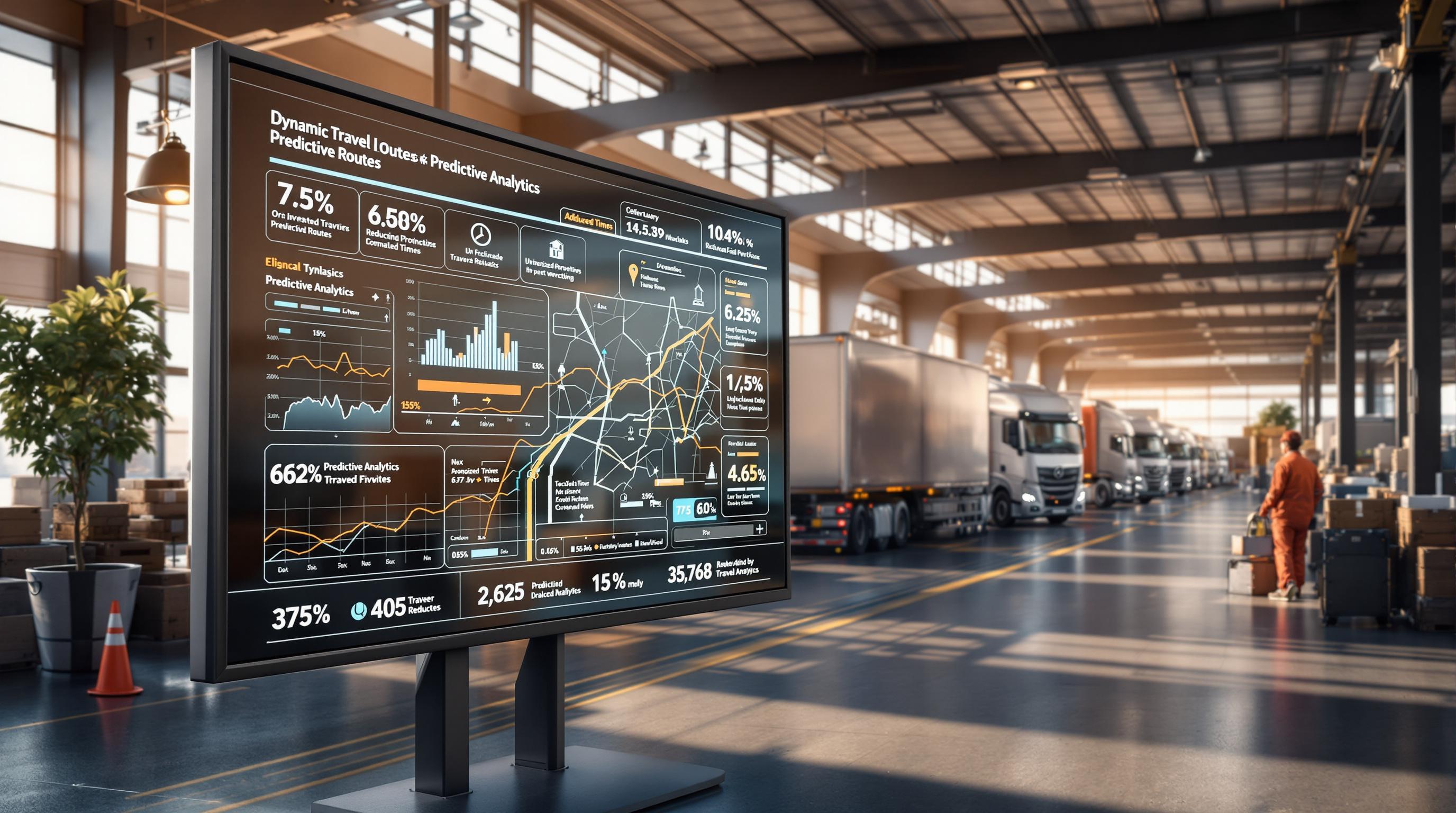AI scheduling tools are transforming how businesses manage their teams. They save time, cut costs, and improve employee satisfaction by automating tedious tasks and predicting staffing needs with precision. Here’s what AI-driven scheduling offers:
- Save Money: Businesses reduce labor costs by 15% annually and administrative costs by 67%.
- Boost Productivity: Companies report 20–30% increases in worker efficiency and fewer schedule disruptions.
- Enhance Employee Satisfaction: Tools account for preferences, reduce overtime, and improve work-life balance.
- Adapt in Real-Time: AI handles last-minute changes, fills gaps, and optimizes schedules on the fly.
- Ensure Compliance: Systems monitor labor laws, break requirements, and overtime limits automatically.
For example, a U.S. utility company saw a 75% drop in emergency disruptions and a 29% increase in job time using AI scheduling. Whether it's reducing scheduling errors or improving forecast accuracy by 80–85%, these tools are reshaping workforce management. Ready to learn how to implement them? Let’s dive in.
Revolutionize Staffing: How AI Simplifies Shift Scheduling
Main AI Scheduling Functions
AI systems are reshaping workforce management by offering capabilities that boost both efficiency and compliance.
Pattern Analysis and Prediction
One of AI's strengths lies in identifying patterns within workforce data to create optimized schedules. By examining historical trends, seasonal fluctuations, and real-time inputs, these systems can forecast staffing needs with precision.
For example, Hilton Hotels leverages AI to align staff schedules with guest demands by analyzing:
- Guest profiles and preferences
- Historical stay patterns
- Real-time feedback
Instant Schedule Updates
AI-powered tools are designed to handle unexpected changes seamlessly, reducing manual scheduling efforts by 15–30% within six months. These systems provide real-time adjustments through features like:
| Feature | Impact |
|---|---|
| Automated Shift Swaps | Quickly processes employee-initiated schedule changes |
| Real-time Notifications | Alerts staff immediately about updates or changes |
| Dynamic Reallocation | Adjusts schedules to match shifting demand |
| Coverage Analysis | Identifies and fills staffing gaps on the spot |
Rules and Laws Compliance
Another major advantage of AI scheduling systems is their ability to ensure adherence to labor laws and organizational policies. For instance, after adopting UKG Dimensions, a nationwide retail chain saw a 20% drop in unnecessary overtime while maintaining adequate staffing during peak periods.
These systems monitor critical compliance factors, such as:
- Maximum allowable working hours
- Mandatory break periods
- Overtime limits
On average, businesses using AI scheduling tools report a 20–35% reduction in the time managers spend on scheduling and a 15–25% improvement in accuracy.
Additionally, Routemize enhances efficiency by optimizing both schedules and travel routes. Its AI adapts in real time to traffic conditions and appointment locations, helping field workers maximize client interaction time while adhering to work-hour regulations.
These capabilities not only streamline operations but also pave the way for improvements in cost management, work-life balance, and travel efficiency, which will be explored in the next section.
Business Results from AI Scheduling
Businesses adopting AI scheduling systems are seeing noticeable improvements across various metrics, from cutting costs to boosting employee satisfaction and streamlining operations.
Cost and Time Savings
Thanks to AI's predictive capabilities and real-time updates, companies are reaping significant financial benefits. Here’s a snapshot of the impact:
| Improvement Area | Average Impact |
|---|---|
| Manager Time on Scheduling | 80% reduction |
| Administrative Costs | 67% decrease |
| False Truck Rolls | 80% reduction |
| Overall Productivity | 20–30% increase |
Enhancing Work-Life Balance for Employees
AI scheduling tools go beyond just efficiency - they also contribute to employee well-being. By factoring in productivity patterns, personal preferences, mandatory breaks, and skill-based task assignments, these systems help avoid excessive overtime and burnout. This has made a real difference, with 60% of employees reporting lower workplace stress.
Reducing Travel Time
When paired with smart routing technologies, AI scheduling takes field operations to the next level. Tools like Routemize use real-time traffic data and appointment locations to cut travel times by up to 20%. This can lead to annual savings of $10,000 per vehicle and a 15% boost in cargo capacity utilization.
A U.S.-based electric and gas utility recently highlighted the transformative power of AI scheduling during a six-week trial:
- 75% fewer emergency schedule disruptions
- 67% drop in job delays
- 29% more time spent on jobs
- 6% increase in completed tasks
These results demonstrate how AI scheduling doesn’t just improve efficiency - it also enhances employee satisfaction and customer experiences. The operational improvements achieved through these systems lay a strong foundation for businesses looking to integrate AI scheduling further.
sbb-itb-7020db0
Setting Up AI Scheduling
Finding Your Needs
Before diving into AI scheduling, it’s important to take a step back and evaluate your current challenges and goals. What scheduling headaches are you facing? Are you dealing with issues like understaffing, excessive overtime costs, or constant last-minute changes? Analyzing your scheduling history can uncover recurring patterns that need attention.
Take the Cleveland Clinic, for example. They used a detailed analysis of their scheduling processes to successfully implement AI solutions that addressed their specific pain points.
Here are some areas to focus on during your evaluation:
| Assessment Area | Considerations |
|---|---|
| Current Process | How much time is spent on scheduling? Are there frequent errors or compliance issues? |
| Staff Feedback | What are employees saying? Are there common complaints about schedules or work-life balance? |
| Business Impact | How are scheduling issues affecting customer wait times, service quality, and costs? |
| Technical Requirements | Can your systems handle integration, and is your data secure and accessible? |
Getting Data Ready
For AI scheduling to work effectively, you need high-quality data - there’s no way around it. Research shows that 64% of businesses believe AI can boost productivity, but that potential relies heavily on the quality of the data you feed into the system.
Here’s how to prepare your data:
-
Data Collection and Cleaning
- Start by gathering historical scheduling data, including employee availability, skill sets, and past scheduling patterns.
- Address any inconsistencies or gaps in the data, as these can throw off the AI’s performance.
-
Integration Planning
- Make sure your systems can “talk” to each other smoothly. A North American telecom company, for instance, achieved 80-85% forecast accuracy by integrating their data daily.
-
Data Security Implementation
- Put strong security measures in place to protect sensitive employee information.
- At the same time, ensure the AI system has the access it needs to process the data effectively.
Once your data is cleaned up and integrated, monitor key performance metrics to confirm that the AI system is delivering results.
Measuring Results
When AI scheduling is implemented correctly, the results can be impressive. Many organizations report noticeable improvements in key areas:
| Metric | Average Improvement |
|---|---|
| Scheduling Time | 60% reduction |
| Administrative Work | 45% reduction |
| Cost-per-hire | 30-40% decrease |
| Time-to-fill Positions | 85% reduction |
To ensure your system stays on track, regularly review:
- How accurate and reliable the schedules are
- Employee satisfaction with their schedules
- Operational cost savings
- Improvements in customer service
- Adherence to compliance requirements
Conclusion: Next Steps in AI Scheduling
AI-powered workforce scheduling is moving beyond quick fixes, aiming instead for proactive and predictive strategies. Across industries, real-world applications are delivering noticeable gains in efficiency, productivity, and employee satisfaction.
To make the most of AI scheduling tools, businesses should prioritize the following areas:
| Focus Area | Impact | Timeline |
|---|---|---|
| Data Quality | 15–25% improvement in schedule accuracy | First 6 months |
| Manager Efficiency | 20–35% reduction in scheduling time | First quarter |
| Employee Satisfaction | Lower turnover and better work-life balance | Continuous effort |
Routemize takes these benefits further by integrating intelligent route optimization into AI scheduling systems, ensuring smoother operations and higher efficiency.
However, success with AI scheduling requires careful planning. According to McKinsey, AI has the potential to contribute $4.4 trillion in productivity gains through corporate applications. To tap into this opportunity, organizations should:
- Define measurable goals to track progress and return on investment (ROI).
- Invest in staff training to ensure the team can effectively use the tools.
- Establish feedback systems for ongoing improvement.
- Prioritize data security to protect sensitive information.
FAQs
How does AI help ensure workforce scheduling complies with labor laws?
AI takes the hassle out of complying with labor laws by automating critical parts of workforce scheduling. It ensures schedules align with regulations like the Fair Labor Standards Act (FLSA) and Family and Medical Leave Act (FMLA) by analyzing employee data and real-time inputs. This means avoiding problems like exceeding maximum working hours or breaking overtime rules.
On top of that, AI handles timekeeping with precision, maintaining accurate records of hours worked and ensuring adherence to minimum wage laws. By spotting potential violations early, it helps businesses reduce legal risks and run smoother operations - freeing them up to focus on achieving their goals while staying on the right side of the law.
What steps should a business take to implement AI scheduling tools effectively?
To make the most out of AI scheduling tools, businesses should begin by setting clear objectives. Pinpoint what you want to achieve - whether it’s minimizing scheduling conflicts, ensuring better staff coverage, or lowering operational costs. Pair these goals with measurable outcomes, like improved efficiency or higher employee satisfaction, to track progress effectively.
Next, focus on your data. It’s crucial that the information fed into the system is accurate, complete, and secure. High-quality data ensures the AI can produce dependable results. Select a scheduling tool that fits your specific needs and works smoothly with your current systems.
Lastly, invest in training your team to use the new tools effectively. Regularly review performance metrics and fine-tune the system as needed. By staying proactive, you can continuously optimize the AI’s performance and unlock its full potential for your workforce.
How does AI improve employee scheduling to support work-life balance and job satisfaction?
AI-powered scheduling tools are transforming the way businesses manage work shifts, making life easier for employees and employers alike. These systems handle the heavy lifting of scheduling by analyzing past data, predicting staffing needs, and aligning schedules with employee preferences. The result? Fewer last-minute changes, less over-scheduling, and a significant drop in workplace stress.
By fine-tuning shift assignments, these tools ensure employees get enough time to recharge, reducing scheduling conflicts and supporting a better balance between work and personal life. On top of that, many of these systems allow employees to have a say in their schedules, which leads to higher engagement, improved morale, and better retention rates. Smarter scheduling doesn’t just create happier employees - it also helps businesses build a more productive and motivated team.


